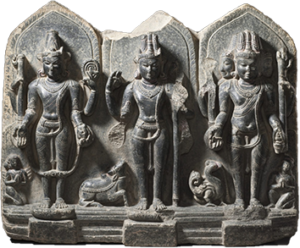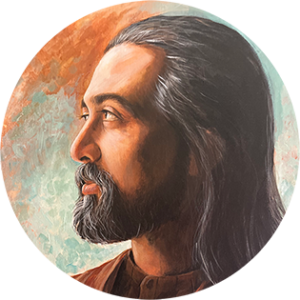Magnificence of Vedic Trinity
Borzou Ghaderi
 1) Based on vedic wisdom, the heart and origin of cosmos is pure consciousness or “Purusha”. To analyze the essence of purusha is meaningless because understanding the vedic approach is not accessible unless through deep meditation and ecstasy but not through arguments. Purusha, the absolute being who is pure intelligence without name, sign or form, is the ocean of eternal love, wisdom and existence and free from all changes and limitations, so his manifestation is also perfect.
1) Based on vedic wisdom, the heart and origin of cosmos is pure consciousness or “Purusha”. To analyze the essence of purusha is meaningless because understanding the vedic approach is not accessible unless through deep meditation and ecstasy but not through arguments. Purusha, the absolute being who is pure intelligence without name, sign or form, is the ocean of eternal love, wisdom and existence and free from all changes and limitations, so his manifestation is also perfect.
“That is full, this is full, from fullness, fullness proceeds”. Brihad aranyaka Upanishad (V-1)
2) Interpretation of vedic scriptures from the quality of purusha manifestation has been explained as: Sat.Chit.Ananda (SCA) or existence, wisdom and love. As the essence of the world is SCA, so all real actions, desires and endeavors are depend on their functions. In fact, this extraordinary vedic trinity is the first definition of unlimited manifestation model for creation. In the other word, the model of creation is programmed based on SCA principle. So, the best model for managing the life depends on SCA theory.
3) Brahma, Vishnu and Rudra, three gods governing creation process are other aspects of this trinity. Brahma is the symbol of creator and we can consider Vishnu as preserver and Rudra or Shiva as annihilator of every cycle of life. Circle as the most perfect form is the Mandala of creation. Life cycles continuously appear and disappear. Brahma is the basic structure and governs new birth (sat). Preserving of creatures depends on realizing the cosmic rules (chit) otherwise the avatars of Vishnu are the symbol of dharma preservers. Finally the reason of ending life cycle is related to merge and dissolve into pure consciousness (ananda).
4) There are three main realms from gross to the most subtle areas based on Rishis’ teachings:
a. Karan Sharira (Causal level)
b. Sukshma Sharira (Astral level)
c. Sthula Sharira (Material level)
In fact these three realms are existed on cosmic energy dance and shakti cycles are not dividing in the purusha. He transcends all the names and marks, qualities and quantities, numbers and diversities, and all such categories loose their peculiarities in him.
This magical trinity which is the fundamental model of creation has got vital role in these three worlds. The trinity of Indra-Agni-Soma governs over karana sharira, as Prana-Tejas-Ojas over sukshma sharira or Vata-Pitta-Kapha over sthula sharira.
Life of each phenomenon depends on creating balance among SCA. Every creature in the world has a portion in each world (3 main worlds) which is related to each other.
Causal level is the nearest to the eternity and govern over astral level and it governs material world. On the other hand, we can consider the 1st world as Sattva, 2nd as Rajas and 3rd as Tamas, therefore creating balance among these tri gunas can open the way to eternity and even beyond three gunas. The important point here is that the shadow of SCA in the prakriti level is sattva, rajas and tamas. In the other word, SCA is the basic model of consciousness manifesting level and related to purusha but S.R.T is the basic model of energy functions and related to prakriti.
Four aims in life
5) The shadow of SCA theory can put down the aims of life also. Sanatan dharma speaks about four goals in the life:
a. Dharma
b. Artha
c. Kama
d. And Moksha as the end of one cycle of life.
We can consider “Dharma” as “Sat” because both are real structures for living. Artha is the wealth which is acquired by dharma rules, otherwise chit is knowledge about basic structure of life, so artha and chit can be understood as the same principles. Finally “kama” is also a natural enjoyment which moves us to merge in the origin of life. Moksha is the end of one cycle and maha moksha is the end of all cycles and going beyond death and birth.
Sat Chit Ananda is an essential model of life cycle, essence of purusha, but when we speak about his manifestation, so each cycle of life appears based on this trinity then disappear in the absolute (moksha) and again appears in new cycle. Therefore at this stage, it has been spoken about four stages. However, 4th stage is not new aspect but just situated in absolute.
6) Again, we can see SCA theory in different stages of human life in sanatan dharma.
a. Brahmacharya: it is the 1st stage of human life which makes the basic model for our mind and governs over the rest of our life, because of this, education in the childhood is so important.
b. Grihasta: it is the 2nd stage and in this period we try to expand our wealth and capital in different aspects.
c. Vanaprasta: it is the proper enjoyment and trying to get ready for liberation.
d. Sannyasa: in this stage we try to detach from all our karmas and going beyond all cycles of life.
In my opinion, SCA theory not only is a great tool for understanding all vedic studies deeply but also it is a unique model for education and treatment.
SCA theory and Yoga
Patanjali in yoga sutras has said: “Yoga is the cessation of the outgoing activities of the mind”. (YS 1/2)
The quality of control on mind activities is achieved through awareness not through the power of the ego. Then it has been mentioned: “then the seer abides in its essential reality”. As we can see he has said that seer (drashtu) abides in its reality not controller or ascetic! So, patanjali has taught us the way of yoga through expanding the awareness, so what is the object of this awareness?
In fact it is discrimination among physical, emotional and intellectual objects and subject or “Atma”.
Therefore there are three main traditions in “Yoga Dharma”:
1) Karma Yoga discrimination between ourselves and physical activities
2) Jnana Yoga discrimination between ourselves and thoughts
3) Bhakti Yoga discrimination between ourselves and emotions
In fact, SCA is the structure of all yogic practices, for example patanjali has a specific definition about “Asana” as “Asanam”, “Sthiram” and “Sukham”.
Asana is the basic structure for each position and related to “Sat” principle.
Sthiram means steadiness which depends on proper knowledge and concentration and is related to chit or tejas principle.
Sukham means relaxing and obviously shows ananda principle. It is complete merging to that position
Finally we can come back to patanjali definition of yoga: “Yogas (Sat) chittavritti (Chit) Nirodha (Ananda) which show SCA theory again.
SCA theory and Ayurveda
An important point in SCA theory is that if the model (dharma) is natural then everything will be OK and naturally move to proper growth and even go beyond that. Because of this, yoga is considered as natural way to self-realization and in Ayurveda we emphasize on person-prakriti as the first step in treatment. After determining the prakriti, we can go to expand our knowledge to find which things can be suitable with that prakriti and finally how may we attain the high natural pleasures and long life.
The most important ideas in Ayurveda are mirrors of SCA theory like tri doshas (vata-pitta-kapha) or prana, tejas and ojas.
SCA theory and jyotisha
Jyotisha as the vedas’ eyes and the science of time can divide the meaning of SCA into different periods.
The Bhavas or houses in the chart are divided into Dharma (1-5-9), Artha (2-6-10), Kama (3-7-11) and Moksha (4-8-12) and we know the relationship between four dharmas and SCA principles. So, there are four main periods in our lives which is comparable with four main periods of history (four yugas) in vedic philosophy of history.
In fact, dharma is the natural and essential structure, artha is expanding it based on its essential possibility and karma is moving to the origin. Therefore, moksha is identical to purusha.
I think the houses 1 to 4 in natal chart are related to dharma at first but on the other hand, we can expand it and see all goals of life in these four houses again. The second quarter is related to artha, 3rd to karma and 4th to moksha. So, an interesting subject in reading charts is examining the lagna in comparison with 4th, 7th and 10th lords (the lords of kendras). So we can see the person’s situation in different period of his life. The farthest house from lagna which shows soul is the 7th house and we can consider it as “Kali Yuga”, As lagna is satya yuga. Now, if the 7th lord is more powerful than lagna, it may show a materialistic person, a person who got stuck in Maya!
